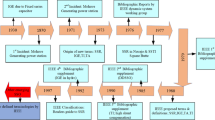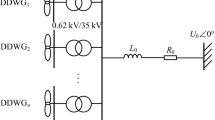Abstract
As the proportion of installed wind power is increasing every year, the dynamic characteristics of the grid-connected system for wind farms are increasingly becoming complex, and the system faces the risk of subsynchronous oscillation (SSO). The uncertainty of wind speed and series compensation degree has significant effects on the SSO of the series-compensated grid-connected system of doubly-fed induction generator (DFIG)-based wind farms. The oscillation risk of the grid-connected wind power systems is highly stochastic and time-varying and is difficult to evaluate accurately and quantitatively. Given the above problems, this paper proposes a risk evaluation method for SSO of the grid-connected system for series-compensated DFIG-based wind farms considering the uncertainty of wind speed and series compensation degree. First, the mechanism and time-varying characteristics of the subsynchronous oscillation of the grid-connected wind power systems are analyzed, and the risk quantification index is accordingly selected. Secondly, according to the oscillation analysis model of the doubly-fed wind farm grid-connected system, the extended Prony and Latin hypercube sampling are used to identify the SSO signal, and the least-squares polynomial method is applied to obtain the indicator model for the corresponding mode. Then, the risk matrix is used to quantify the probability and severity of the occurrence of subsynchronous oscillation risk caused by the uncertainty of the grid-connected wind farm systems. Finally, examples are presented to verify the effectiveness and viability of the proposed method.









Similar content being viewed by others
References
Leon AE (2015) Integration of DFIG-based wind farms into series-compensated transmission systems. IEEE Trans Sustain Energy 7(2):451–460
Adams J, Carter C, Huang SH (2012) ERCOT experience with sub-synchronous control interaction and proposed remediation. In: PES T&D 2012. IEEE, pp 1–5
Ma Y, Huang Q, Gooi HB et al (2022) Subsynchronous oscillation analysis using multisynchrosqueezing transform and dissipating energy flow method. IEEE Trans Ind Appl 58(3):3134–3141
Shair J, Xie X, Yang J et al (2021) Adaptive damping control of subsynchronous oscillation in DFIG-based wind farms connected to series-compensated network. IEEE Trans Power Deliv 37(2):1036–1049
Trevisan AS, Fecteau M, Mendonça  et al (2021) Analysis of low frequency interactions of DFIG wind turbine systems in series compensated grids. Electric Power Syst Res 191:106845
Gao C, Liu H, Jiang H et al (2017) Research on the sub-synchronous oscillation in wind power connected to series compensated power system and its influencing factors. CES Trans Electr Mach Syst 1(3):334–340
Mohammadpour HA, Santi E (2015) Analysis of sub-synchronous resonance (SSR) in doubly-fed induction generator (DFIG)-based wind farms. Synth Lect Power Electron 5(3):1–64
Xie X, Liu H, He J et al (2018) Analysis of new oscillation problems in power systems. Chin J Electr Eng 38(10): 2821–2828, 3133
Xie X, Li H (2020) Research progress of power system oscillation. Sci Bull 65(12):1119–1129
Liu S, Wang X, Yang B et al (2019) Quantitative analysis method for subsynchronous oscillation stability of wind power system based on impedance model. China South Power Grid Technol 13(5):66–71
Liu H, Xie X, Zhang C et al (2016) Quantitative SSR analysis of series-compensated DFIG-based wind farms using aggregated RLC circuit model. IEEE Trans Power Syst 32(1):474–483
Du W, Wang Y, Wang HF et al (2019) Open-loop modal analysis to identify the SSO instability risk caused by grid-connected wind farms. Int J Electr Power Energy Syst 107:352–362
Xu QS, Huang Y, Liu JK et al (2016) Probabilistic load flow method using Monte-Carlo simulation based on Gaussian mixture model and marginal transformation. Autom Electric Power Syst 40(16):23–30
Xie ZQ, Ji TY, Li MS et al (2017) Quasi-Monte Carlo based probabilistic optimal power flow considering the correlation of wind speeds using copula function. IEEE Trans Power Syst 33(2):2239–2247
Hasan KN, Preece R (2017) Influence of stochastic dependence on small-disturbance stability and ranking uncertainties. IEEE Trans Power Syst 33(3):3227–3235
Ma Y, Liu J, Yan J (2017) Small disturbance stability analysis of power system containing wind power based on stochastic response surface method. Trans China Electrotech Soc 32(6):49–57
Chen W, Wang D, Su D et al (2017) Safety risk assessment method for the effect of induction generators in doubly-fed wind farms. Power Grid Technol 41(3):854–862
Tao S, Liu Y, Yan Y et al (2021) SSO risk evaluation for grid-connected PMSG-based wind farm based on sequential Monte Carlo simulation. CSEE J Power Energy Syst
Chen W, Xie X, Wang D et al (2017) Probabilistic stability analysis of subsynchronous resonance for series-compensated DFIG-based wind farms. IEEE Trans Sustain Energy 9(1):400–409
Leon AE, Solsona JA (2014) Sub-synchronous interaction damping control for DFIG wind turbines. IEEE Trans Power Syst 30(1):419–428
Ali MT, Zhou D, Song Y et al (2019) Analysis and mitigation of SSCI in DFIG systems with experimental validation. IEEE Trans Energy Convers 35(2):714–723
Chernet S, Beza M, Bongiorno M (2019) Investigation of subsynchronous control interaction in DFIG-based wind farms connected to a series compensated transmission line. Int J Electr Power Energy Syst 105:765–774
Li G, Wang W, Zhang X et al (2022) Modeling and mechanism analysis of grid-connected sub/super-synchronous in doubly-fed wind farms (I): impedance modeling considering the power outer loop. Proc CSEE 42(7):2438–2449
Shair J, Xie X, Li Y et al (2020) Hardware-in-the-loop and field validation of a rotor-side subsynchronous damping controller for a series compensated DFIG system. IEEE Trans Power Deliv 36(2):698–709
Sajadi A, Zhao S, Clark K et al (2018) Small-signal stability analysis of large-scale power systems in response to variability of offshore wind power plants. IEEE Syst J 13(3):3070–3079
Gu B, Zhang T, Meng H et al (2021) Short-term forecasting and uncertainty analysis of wind power based on long short-term memory, cloud model and nonparametric kernel density estimation. Renew Energy 164:687–708
Preece R, Milanović JV (2014) Risk-based small-disturbance security assessment of power systems. IEEE Trans Power Deliv 30(2):590–598
Funding
This research was supported by the National Natural Science Foundation of China (51767017, 51867015), and the Gansu Province Basic Research Innovation Group Project (18JR3RA133).
Author information
Authors and Affiliations
Contributions
WC contributed to conceptualization, methodology, formal analysis, writing—review and editing, funding acquisition, supervision. ZL contributed to conceptualization, methodology, validation, formal analysis, investigation, resources, data curation, writing—original draft, visualization. ZW contributed to resources, writing—review and editing. JS contributed to writing—review and editing. ZX contributed to writing—review and editing.
Corresponding author
Ethics declarations
Competing interests
The authors declare that they have no known competing financial interests or personal relationships that could have appeared to influence the work reported in this paper.
Additional information
Publisher's Note
Springer Nature remains neutral with regard to jurisdictional claims in published maps and institutional affiliations.
Rights and permissions
Springer Nature or its licensor (e.g. a society or other partner) holds exclusive rights to this article under a publishing agreement with the author(s) or other rightsholder(s); author self-archiving of the accepted manuscript version of this article is solely governed by the terms of such publishing agreement and applicable law.
About this article
Cite this article
Chen, W., Liu, Z., Wei, Z. et al. SSO risk evaluation method for grid-connected wind farm systems based on LHS and extended Prony. Electr Eng 105, 853–865 (2023). https://doi.org/10.1007/s00202-022-01702-5
Received:
Accepted:
Published:
Issue Date:
DOI: https://doi.org/10.1007/s00202-022-01702-5




